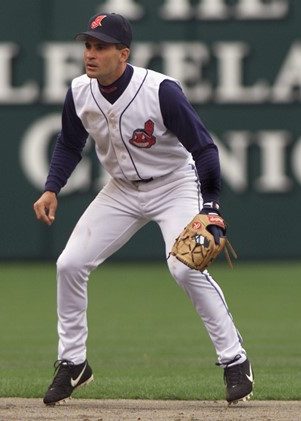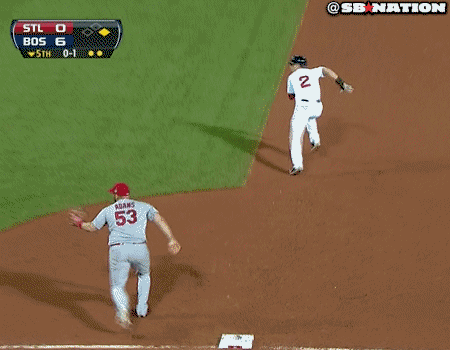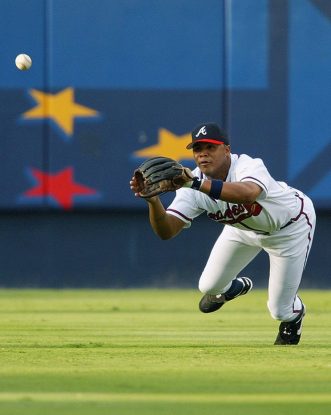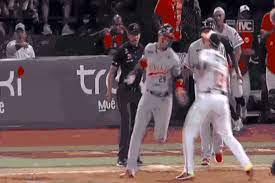
“A savant in the batter’s box . . . an idiot everywhere else.”—Jay Jaffe, on Manny Ramírez.
But wait . . . there’s more! Namely, the rest of the Baseball Writers Association of America Hall of Fame ballot, the candidates returning for another go-round. They’re not going to Cooperstown. Three in particular have actual Hall cases but aren’t likely to go this time, and maybe not for a few more times—if at all—before their BBWAA ballot eligibility expires.
Two were murderers at the plate. One was a shortstop acrobat. Two were considered head cases while they played; the acrobat’s days since his career ended have fallen into deep enough disrepute. The murderers at the plate are Manny Ramírez (LF) and Gary Sheffield (RF); the acrobat at shortstop is Omar Vizquel.
There are ten left fielders, eleven right fielders, and ten shortstops in the Hall of Fame who played their careers all or mostly in the post-World War II/post-integration/night-ball era. The following table shows Ramírez, Sheffield, and Vizquel according to my Real Batting Average (RBA) metric—total bases + walks + intentional walks + sacrifice flies + hit by pitches, divided by total plate appearances. The parenthetic numbers next to their names indicate their positioning among those Hall of Famers at their positions, if they do become Hall of Famers themselves:
| Player | PA | TB | BB | IBB | SF | HBP | RBA |
| Manny Ramírez (LF; 2) | 9774 | 4826 | 1329 | 216 | 90 | 109 | .672 |
| Gary Sheffield (RF; 6) | 10947 | 4737 | 1475 | 130 | 111 | 135 | .602 |
| Omar Vizquel (SS; 9) | 12013 | 3727 | 1028 | 25 | 94 | 49 | .409 |
Manny Being Manny
Manny Ramírez’s Hall of Fame case is entirely in his bat. He’s got the numbers at the plate for enshrinement. No questions asked. He also has the attitude history (Manny Being Manny) and issues that made him as big a pain in the butt to his own teams as he was to opposing pitchers.
First, we’ll address his defense. It all but didn’t exist. Ramírez wasn’t just below his league average for the traditional fielding percentage and range factors, his career finished with him being worth -109 defensive runs below his league average. He should have been a designated hitter. (And, was—for a mere fourteen percent of his 2,302 lifetime games.)
The best side of Ramírez was that, in Cleveland and Boston especially, he was known for a tremendous work ethic. He all but included that in his thinking when he said, so memorably, after winning the 2004 World Series MVP as those Red Sox swept the Cardinals to break the actual/alleged curse, “I don’t believe in curse, I believe you make your own destiny.”
That was the blessing. And, the big problem. Because Ramírez made his own destiny, all right, perhaps encapsulated best by The Cooperstown Casebook author Jay Jaffe: “A savant in the batter’s box, Manny Ramírez could be an idiot just about everywhere else—sometimes amusingly, sometimes much less so.”
Any amusement factor in Manny Being Manny died long before his playing career finally did. You can hark back to all the times he seemed to want out of Boston, and the time the Red Sox put him on irrevocable waivers after the 2003 season only to find no takers—even knowing a claiming team would have to surrender no talent in return.
The Yankees could have had afforded the remaining five years/$104 million on his contract, Jaffe noted; they reached for Gary Sheffield, instead, and Sheffield was seen as his own kind of head case. The Angels could have had afforded him, too; they reached, instead, for Hall of Famer Vladimir Guerrero, who became an Anaheim fan favourite his entire time there.
As Jaffe reminds us:
There was the time in 1997 that [Ramírez] “stole” first base, returning to the bag after a successful steal of second because he thought [Hall of Famer] Jim Thome had fouled off a pitch . . . the time in 2004 that he inexplicably cut off center fielder Johnny Damon’s relay throw from about thirty feet away, leading to an inside-the-park home run . . . the time in 2005 when he disappeared mid-inning to relieve himself inside Fenway Park’s Green Monster… the time in 2008 that he high-fived a fan mid-play between catching a fly ball and doubling a runner off first . . . and so much more.
. . . But there was also a darker side, one that, particularly after he left the Indians, went beyond the litany of late arrivals to spring training, questionable absences due to injury (particularly for the All-Star Game), and near-annual trade requests. Most notably, there was his shoving match with 64-year-old Red Sox traveling secretary Jack McCormick in 2008, which prefigured Ramirez’s trade to the Dodgers that summer, and a charge of misdemeanor domestic violence/battery in 2011 after his wife told an emergency operator that her husband had slapped her face, causing her to hit her head against the headboard of the bed. (That domestic violence charge was later dropped after his wife refused to testify.) Interspersed with those two incidents were a pair of suspensions for performance-enhancing drug use, the second of which ran him out of the majors.
Those suspensions for actual or alleged performance-enhancing substances were handed down to him after the so-called Wild West Era during which the rules were that there were no rules. They may also have handed down the final portion of his blockage from the Hall of Fame in the end.
But if you were to establish a Hall of Their Own Worst Enemies, Ramírez would likely be first ballot, unanimous. More’s the pity.
Sheffield of Dreams

Gary Sheffield, a study in destruction at the plate whose defense undermines his Hall of Fame case drastically.
Strictly by his counting statistics, Gary Sheffield has a Hall of Fame case. His talent was as outsized as his reputation for self-centricity. He was a study in pending destruction at the plate and he had a concurrent one-for-one-and-all-for-Gary reputation. He also found himself mistrustful of team management after his first team, the Brewers, absolutely mishandled him starting with an injury first mis-detected.
Sheffield also had a very strange problem for a guy whose career came largely in a high-offense era and who could invoke terror with one swing: he played too much in home parks that didn’t really favour righthanded hitters. (His time in Dodger Stadium was an exception; he hit very well there.) That plus the nagging injuries he battled for much of his career land Sheffield in a strange position.
For all his home runs (509), for all that he sits in the top 25 for walks and runs created, his offensive winning percentage (.687) puts him just inside the top one hundred. A player that talented with his kind of stats should have pulled up a lot higher. Especially since he was far enough more difficult to strike out than to walk—lifetime, Sheffield walked exactly 300 times more than he struck out.
If you look at him according to wins above replacement-level player (WAR), Sheffield’s defensive deficiences slaughter him, fat worse than Ramírez’s do him. Sheffield had a fine throwing arm but his -195 fielding runs below league average left him the second lowest of all time. It’s the reason why his peak and career WAR are well below the Hall of Fame standard for right fielders.
In some ways Sheffield was a wronged man. When the Brewers sent him down early in his career after accusing him of faking an injury, he wanted out and badly. He tended to nuke more than burn bridges when he felt he was done wrong. He was also accused falsely of tanking plays with the Brewers after a hard wild throw in the minors caused a rift with a manager who subsequently apologised to him.
He got dinged by the BALCO case when it turned out he really might have been tricked into using an actual or alleged performance-enhancing substance. It’s also important to know that that occurred before baseball finally faced the issue and implemented testings and penalties, and Sheffield didn’t exactly make it his life’s indulgence.
Even the hardest-line writers against actual or alleged PEDs inclined to give Sheffield the benefit of the doubt, including and especially Tom Verducci of Sports Illustrated, a man not known to suffer actual or alleged PEDs and their users gladly:
Sheffield is the only star I know who, as an active player, without provocation admitted to using steroids; he did so in a 2004 SI story I wrote. Why would he make an admission? Because, he told me, he had testified under oath that he had been duped into using them.
Sheffield said he told the BALCO grand jury the previous year that [Barry] Bonds arranged for him to use “the cream,” “the clear” and “red beans,” which prosecutors identified as steroid pills from Mexico. Sheffield, however, said he was told the substances were legal arthritic balms or nutritional supplements . . . When he later learned that the BALCO products were steroids, he told me, “I was mad. I want everybody to be on an even playing field.”
That’s it; we have no evidence that ties Sheffield to steroids other than those several weeks before the 2002 season when Sheffield lived at Bonds’s home. Even during that 2002 season, when players were resisting the idea of steroid testing, Sheffield spoke out in favor of it [see here], saying, “I would like to see testing. I mean you see how much guys are using it. Unless you’ve got something to hide, you won’t mind testing, right?”
There are far more prickly men in the Hall of Fame than him. There are Hall of Famers who were their own worst enemies to a far greater extent. There are such players (see Ramírez, Manny, for one) who have been and will be kept out of Cooperstown. Sheffield may end up having to wait for the Contemporary Baseball Era Committee to send him there, but he wasn’t just a study in likely destruction at the plate. His terrible fielding undermines it far more, but he has a genuine Hall of Fame case.
If he makes it at last, Sheffield probably won’t be one hundredth as controversial a Hall of Famer as Harold Baines is (for his record, not his person) and Curt Schilling may yet become. (For his person, not his record, which is now before that Contemporary Era Committee.)
The Rubaiyat of Omar Vizquel

Omar Vizquel, a Hall-worthy candidate as a defensive shortstop, but whose domestic abuse and sexual harassment issues may block his entry.
Even if I believe the Hall of Fame should pay a lot more attention to run prevention, and I do, I’m not settled firmly on either side of yes or no regarding Vizquel. But that’s taken strictly on field terms. The in-depth revelation of domestic violence accusations, plus subsequent sexual harassment accusations while he managed in the White Sox system, affected his Hall vote last year, may yet obstruct his path entirely, and leaves me with a taste in my mouth that’s comparable to a castor oil martini.
I once sketched a rather elaborate take on why you should vote for Vizquel if you’re going to vote for him. It hooked mostly around the impression a) that he wasn’t as close to being the second coming of Ozzie Smith as people remember him being, though he looked that way; but, b) that he was the outstanding defensive shortstop of the 1990s. If you’re talking about players whose major or sole selling point is defense and enough of it, and have the highlight reels to back them up, Vizquel in the ’90s certainly looks like The One.
His acrobatics happened often enough to convince lots of Gold Glove voters in those years. But the bad news is that Hall of Famer Cal Ripken, Jr. was better with the glove in that decade . . . and he didn’t play the position past 1996 except for three games in 1998. Even playing less of that decade than Vizquel played at shortstop, Ripken was worth a lot more defensive runs above the league average.
Ripken wasn’t quite the acrobat Vizquel often was, but Ripken did the job in the field very well above league average. Vizquel was worth +128 fielding runs lifetime; Ripken was worth that just from 1990-96. If you want to put a defense-first lineup out there, take the shortstop worth +181 lifetime fielding runs (third in history behind Mark Belanger and Ozzie Smith) over the one worth +128.
Now think of the two-way lineup, the lineup full of men who’d be Hall of Famers on both sides of the ball. Who are you really going to choose at shortstop—the guy with the 112 OPS+ (Ripken) or the guy with the 82 OPS+ (Vizquel)?
Vizquel turned up a few hits shy of 3,000 in 22 seasons. (He also walked only 58 fewer times than he struck out.) But it isn’t just milestones or totals that make a Hall of Famer. His real other apparent selling point is his longevity, and I’ve bumped into only too many people around the baseball forums who want to put him in on the Harold Baines factor: that the Hall of Fame won’t be soiled if it’s the Hall of the Gold Watch.
Well, yes it will. And, yes it is. That argument doesn’t fly. Just because one Era Committee was foolish enough to elect Baines it doesn’t mean he should be any sort of Hall of Fame standard. It’s rare enough for a player to get two decades in the big leagues, of course, but by itself that isn’t and shouldn’t be enough for the Hall of Fame.
The Hall of Fame is supposed to be about greatness, not time in service, other than the ten-season minimum for eligibility. Greatness, not mere acrobatics. (Anyone who thinks Brooks Robinson or Ozzie Smith got to Cooperstown merely by being acrobats on the left side of the infield doesn’t know their actual run-prevention records.) Greatness, not merely showing up for work every day. (Once and for all: there was a lot more to Cal Ripken, Jr. than just breaking Lou Gehrig’s consecutive games streak.)
Vizquel shakes out as the number 42 shortstop of all-time. Ripken, in case you wondered, shakes out as number three. Álex Rodríguez shakes out as number two, but he’s there strictly because of his hitting—he wasn’t anywhere near Vizquel or Ripken defensively. (A-Rod, of course, has his own controversies shadowing his Hall candidacy.)
You don’t have to compare Vizquel to Ripken exclusively to try making his Hall of Fame case. I’m not entirely convinced that being just inside the top fifty by eight equals a Hall of Famer, either. Just off that alone, I could be persuaded one way or another. But his domestic violence/sexual harassment issues (before you think about feeling terrible for him, you should feel more terrible for his victims) make his Hall entry less likely than they might have been before those came to sad light.
————————————————————-
Some of the foregoing has been published previously.






